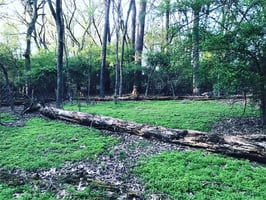The Keeley Institute In the late 19th century, as opium and alcohol addiction rates soared in...
Keller's Quarry: Sandstone & Limestone

Keller's Quarry in Tuscumbia, Alabama, nestled along the Tennessee River, played a key role in Tennessee River transportation during the late 19th and early 20th centuries. This historic site was a significant source of sandstone and limestone used in various construction projects throughout the region.
The quarry's origins can be traced back to Captain A.H. Keller, the father of the legendary Helen Keller. Captain Keller, with his keen business acumen, recognized the potential of the local sandstone deposits and invested in the quarry.
Keller's Quarry Was A Vital Resource
The sandstone extracted from Keller's Quarry was a valuable commodity, particularly during the construction of the canal at Riverton. In 1897, stone from the quarry was transported to Riverton to be used in the lock’s construction. The completion of the big lock at Riverton in 1899 marked a significant milestone in this project, and the demand for sandstone from Keller's Quarry increased.
The U.S. government began paying royalties on the stone from Keller Quarry to furnish rock for the work at Colbert Shoals. About 150 laborers (mostly Black men from the area) were given employment. The superintendent of the government’s work on Colbert Shoals was Thomas Crow and the Chief Clerk was W.T. Standifer.
Work at Keller’s Quarry Was A Dangerous Occupation
Working in a quarry is a hazardous occupation, and Keller's Quarry was no exception. The process of extracting stone involved the use of explosives, which posed a constant threat to the workers. Tragically, several accidents occurred at the quarry, resulting in the loss of lives. One of the laborers, Sam Hofman - aged 22, died at the quarry after setting off a dynamite blast that fell a stone weighing 4 or 5 tons right on top of him, “mashing him into jelly”. A month later, stonecutter Stephen Morris died in an almost identical fashion.
Keller’s Quarry: A New Industrial Era in Concrete?
At the end of 1922, the City of Sheffield announced that a large cement factory was to move into Keller Quarry and begin operations by July 1st of 1923. The factory was to be built in units (at least 3), each capable of producing 2,000 barrels of concrete daily. This ambitious project, representing a significant investment of $1 million, was expected to create over 1,000 jobs but never came to fruition. Today, leftover sandstone cut for the Colbert Shoals project remains on the property.


